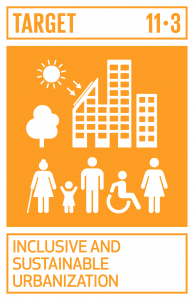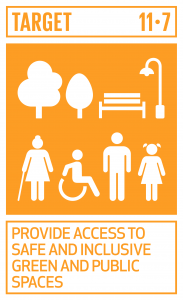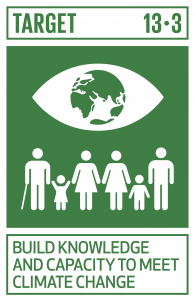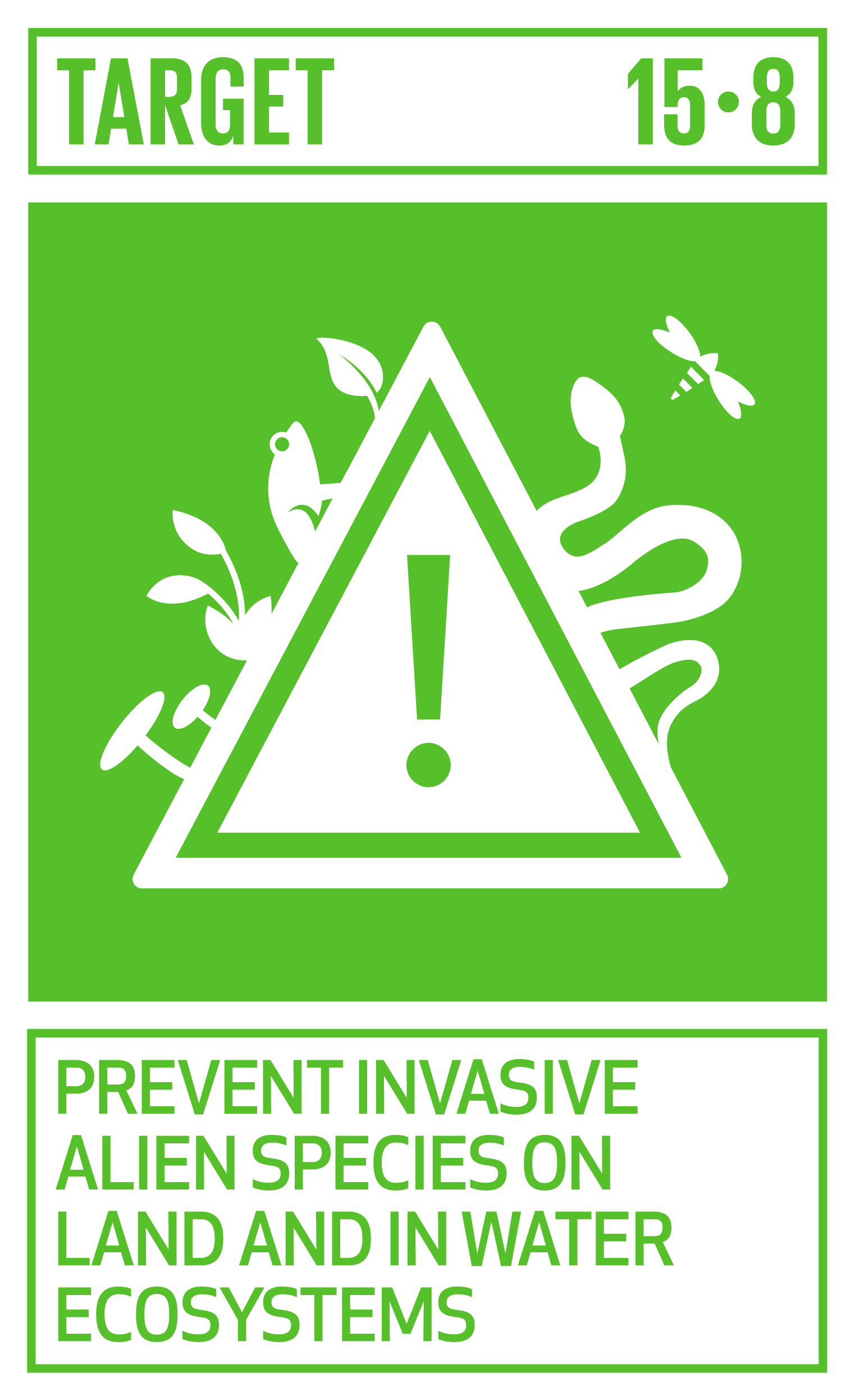The City of Los Angeles is fortunate to be located within a globally recognized hotspot of native biodiversity. While Los Angeles is a biodiversity jewel, this designation also means that the biodiversity here is threatened, and innovative strategies are needed to ensure its resilience and sustainability. A student team worked with the Los Angeles Bureau of Sanitation and Environment for 10 weeks to develop methodologies to measure biodiversity metrics as part of the Los Angeles Biodiversity Index.
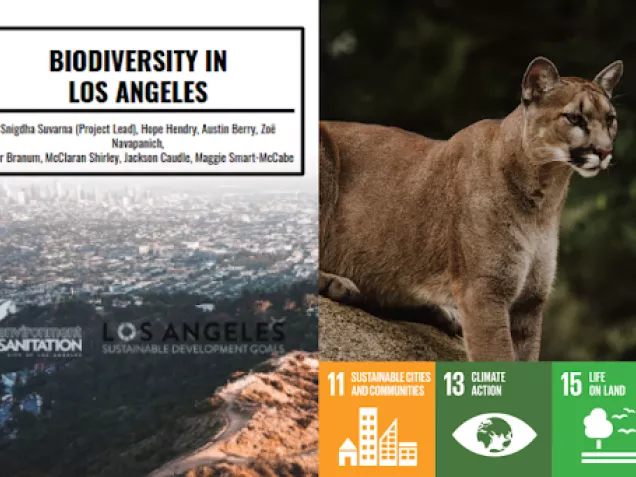
Background
The City of Los Angeles comprises a unique urban ecosystem -- nestled between the Pacific Ocean and vast mountain ranges. Despite being an urban center, Los Angeles has an abundance of rich native wildlife within its City limits. As part of the 2020 Los Angeles SDG Summer Cohort, our student group conducted research relevant to SDG 15: Life on Land. In partnership with the City of Los Angeles Bureau of Sanitation and Environment (LASAN)’s ongoing work on biodiversity, each of our team members focused on specific indicators of the Los Angeles Biodiversity Index. The City Biodiversity Index is used to create a localized benchmark for biodiversity conservation in cities and was adapted from the Singapore Index in order to fully encapsulate and effectively measure the unique biodiversity within Los Angeles. In total, we researched and worked toward measurements of nineteen out of the twenty-four indicators, within the following categories: Native Species Protection & Enhancement, Social Considerations & Biodiversity, and Governance & Management of Biodiversity. Below are brief descriptions and key findings from these eight projects, along with the alignment to the SDG targets and Biodiversity Index indicators addressed.
Intern Projects
Public Access to Nature (Hope Hendry)
Research Question: What portion of the Los Angeles population has the most difficulty accessing natural areas?
UN SDG Targets Addressed: 3.4, 15.9, 11.3
Biodiversity Index Indicators: 2.1a
Methodology: We conducted a 0.5-mile driving/walking network analysis around the perimeter of all accessible natural areas within the City using data mapping tools in ArcGIS to measure the proportion of residents who have easy access to nature. Based on these findings, our research assessed accessibility through a lens of race, age, socioeconomic factors, and public health using demographic data from CalEnviroScreen 3.0.
Results: Our research shows that African American, Hispanic, and youth populations experience the lowest accessibility to natural areas in the City. Based on our deliverables, the city government can make decisions on how to proceed with increasing public access to nature.
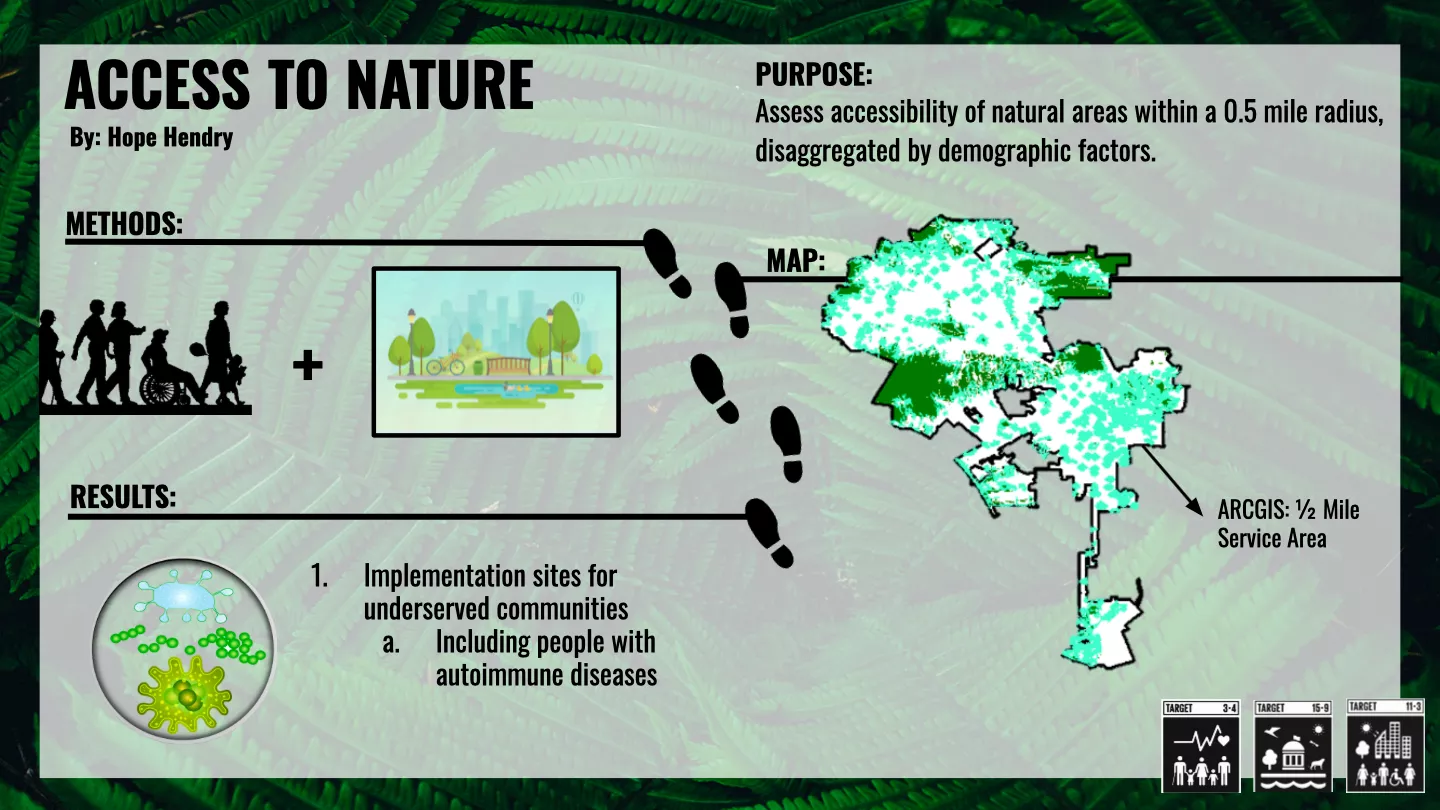
Urban Natural Area Protection and Management (Austin Berry)
Research Question: How has urban natural area protection and management changed since it was previously measured in 2018?
UN SDG Targets Addressed: 15.8, 15.9, 11.3, 11.5
Biodiversity Index Indicators: 1.1a, 1.1b, 1.3b, 1.3c, 3.2a
Methodology: We calculated the invasiveness measurements of plant species within City boundaries and analyzed the change in protected natural areas using data provided by the California Protected Areas Database (CPAD) and California Conservation Easement Database (CCED). One of the outputs of this project was a database of species locations and their invasiveness level.
Results: Our research found that L.A. had a net overall increase in protected land between 2016 and 2020. As for invasive plants in the area, 142 unique species were documented within City boundaries. The invasive species database can help the City make containment and eradication decisions based on the prevalence and level of invasiveness of certain species in neighborhoods across Los Angeles. Further, the database allows the City to investigate the emergence of invasive species throughout Los Angeles, whether through commercial imports or naturally spreading species.
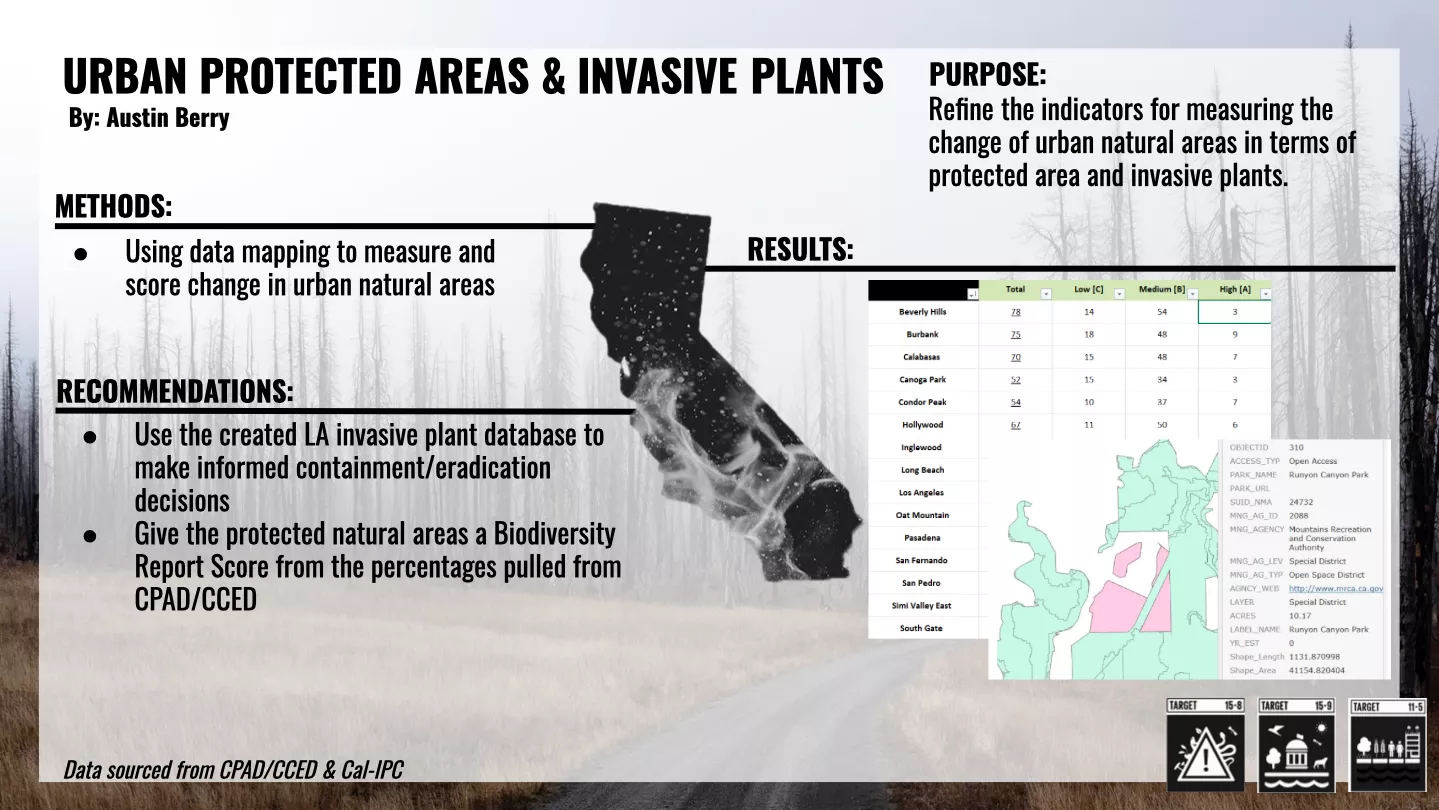
Wildlife Connectivity (Snigdha Suvarna)
Research Question: Are there potential wildlife linkages within Los Angeles that can improve species connectivity between habitat areas?
UN SDG Targets Addressed: 15.1, 15.5, 15.6
Biodiversity Index Indicators: 1.1c, 1.1d
Methodology: Using the Green Visions Plan of 2005, we selected nine target taxa to focus our analysis. This included charismatic species, non urban tolerant species, and species that are found in a variety of areas across Los Angeles. This research applied circuit theory and resistance modeling techniques -- which measure the impact of landscape configuration on organisms and population movement patterns. We mapped natural areas and iNaturalist species observation data with potential hazard areas to identify locations where investments could be made to protect natural pathways for these species.
Results: Our research created a methodology for how to find least-cost pathways of species connectivity between habitats. Further, we found five potential wildlife linkage pathways between the Santa Monica and Griffith Park regions. This information can aid city planners in identifying key parcel areas that need to be protected and restored for wildlife connectivity.
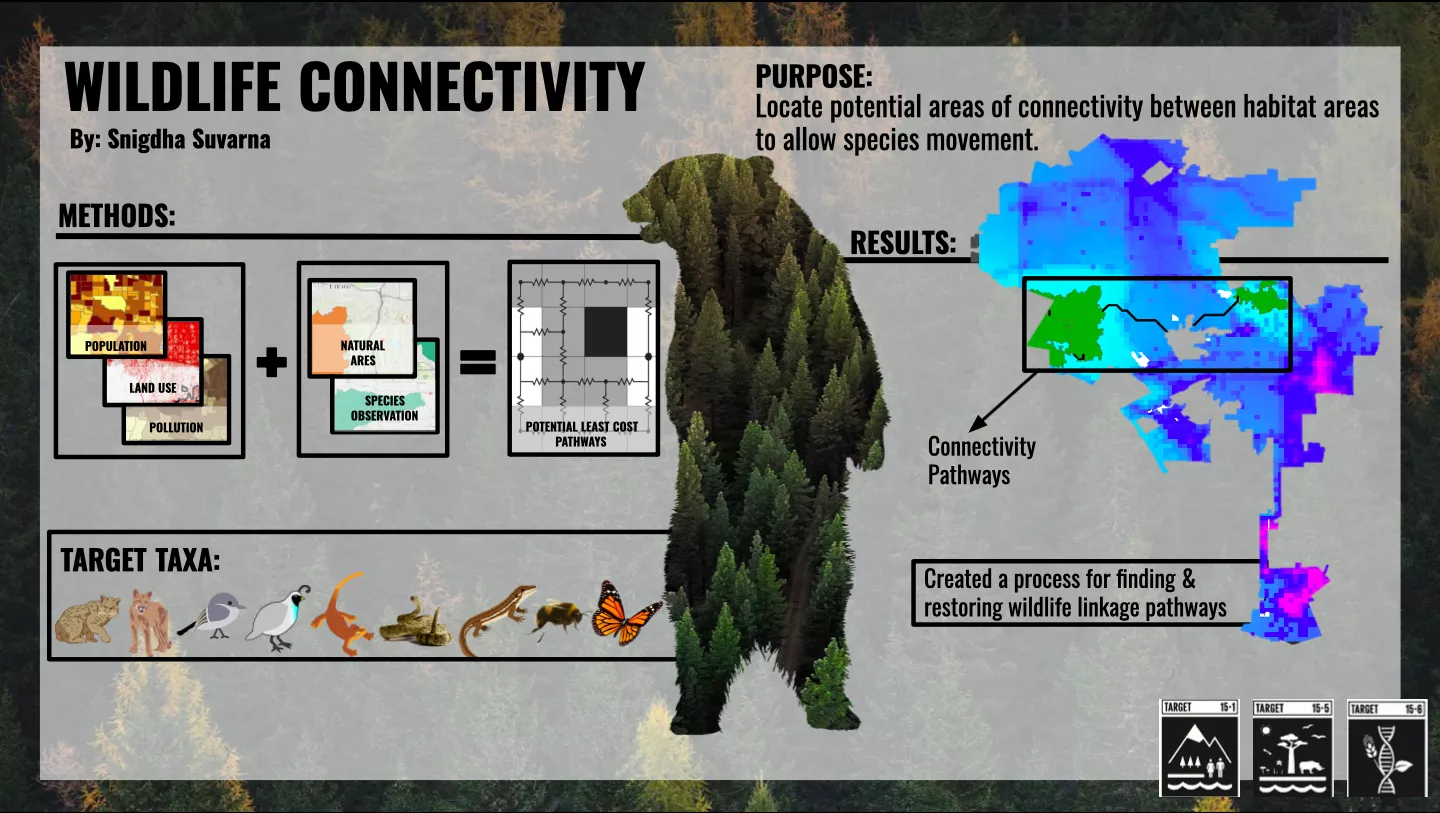
Charismatic Umbrella Species and sensitive indicator species (Jackson Caudle)
Research Question: What are some of the charismatic umbrella and sensitive indicator species within Los Angeles and in what areas can these species be found?
UN SDG Targets Addressed: 15.5, 15.7, 15.9
Biodiversity Index Indicators: 1.2a, 1.2c
Methodology: We developed a database that documents potential charismatic umbrella and sensitive indicator species. We defined charismatic umbrella species as easily recognizable species that can protect large areas of natural land and sensitive indicator species as species that can provide early information about the health of an environment.
Results: Our research found that the Santa Monica and San Gabriel Mountains had the highest number of species observed in Los Angeles. This database can be used as a guideline to track these key species and to better understand the wellbeing of LA’s natural spaces.
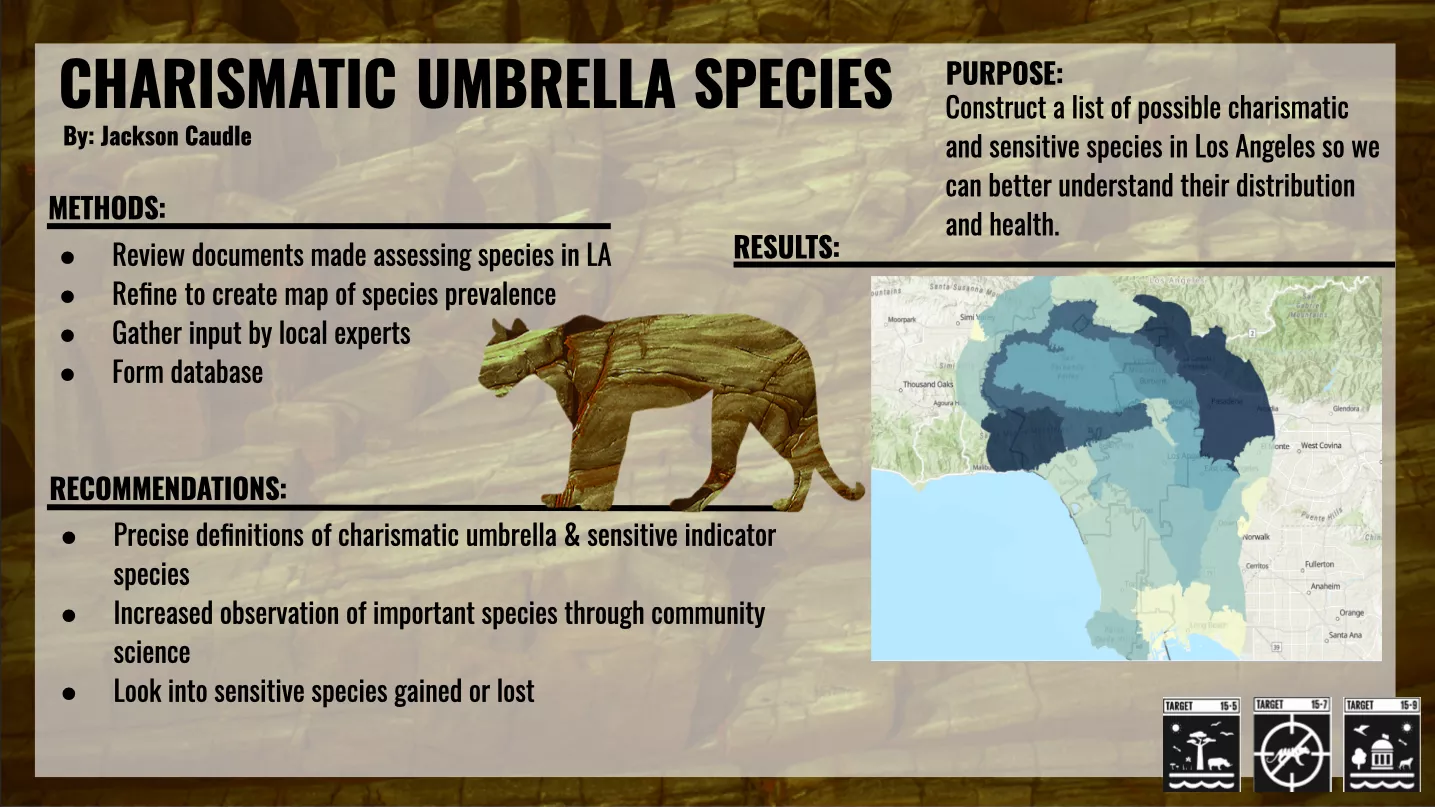
Native Fauna Monitoring (Zoe Navapanich)
Research Question: How is native fauna monitored within Los Angeles?
UN SDG Targets Addressed: 15.1, 15.5, 15.9
Biodiversity Index Indicators: 1.2b
Methodology: We designed a comprehensive database of species that serves as a resource for basic information about L.A. native species. Our work showcases change over time as the data is updated based on community science-sourced occurrence data. This database assigned each species an “Urban Tolerance” score based on their habitat needs and ability to live in areas of varying populations.
Results: Our project encourages the City to use the newly created urban tolerance scores to improve the monitoring of native fauna.
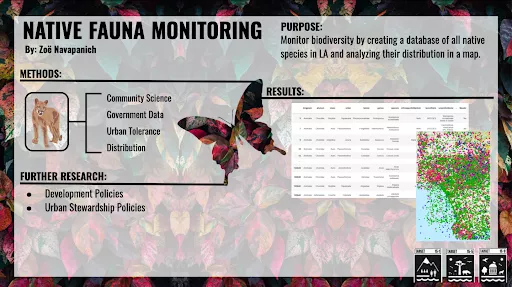
Biodiversity in Education (Maggie Smart-McCabe)
Research Question: How can the City better assess biodiversity education opportunities in schools’ curriculum, field trips, and educational gardens and biodiversity habitats in K-12 LAUSD schools?
UN SDG Targets Addressed: 4.1, 4.7, 11.3, 15.3
Biodiversity Index Indicators: 2.2a, 2.2b, 2.2c
Methodology: We conducted outreach to a network of stakeholders involved in biodiversity programming and instruction at K-12 schools, community partner organizations, and educational centers.
Results: This project identified community-based providers of biodiversity education with which LASAN or the City could further develop an ecosystem of community partnerships between local biodiversity and environmental justice thought-leaders. Given the reality of remote learning, such a network may be essential to augmenting curriculum, particularly given a potential absence of outdoor time and/or physical education.
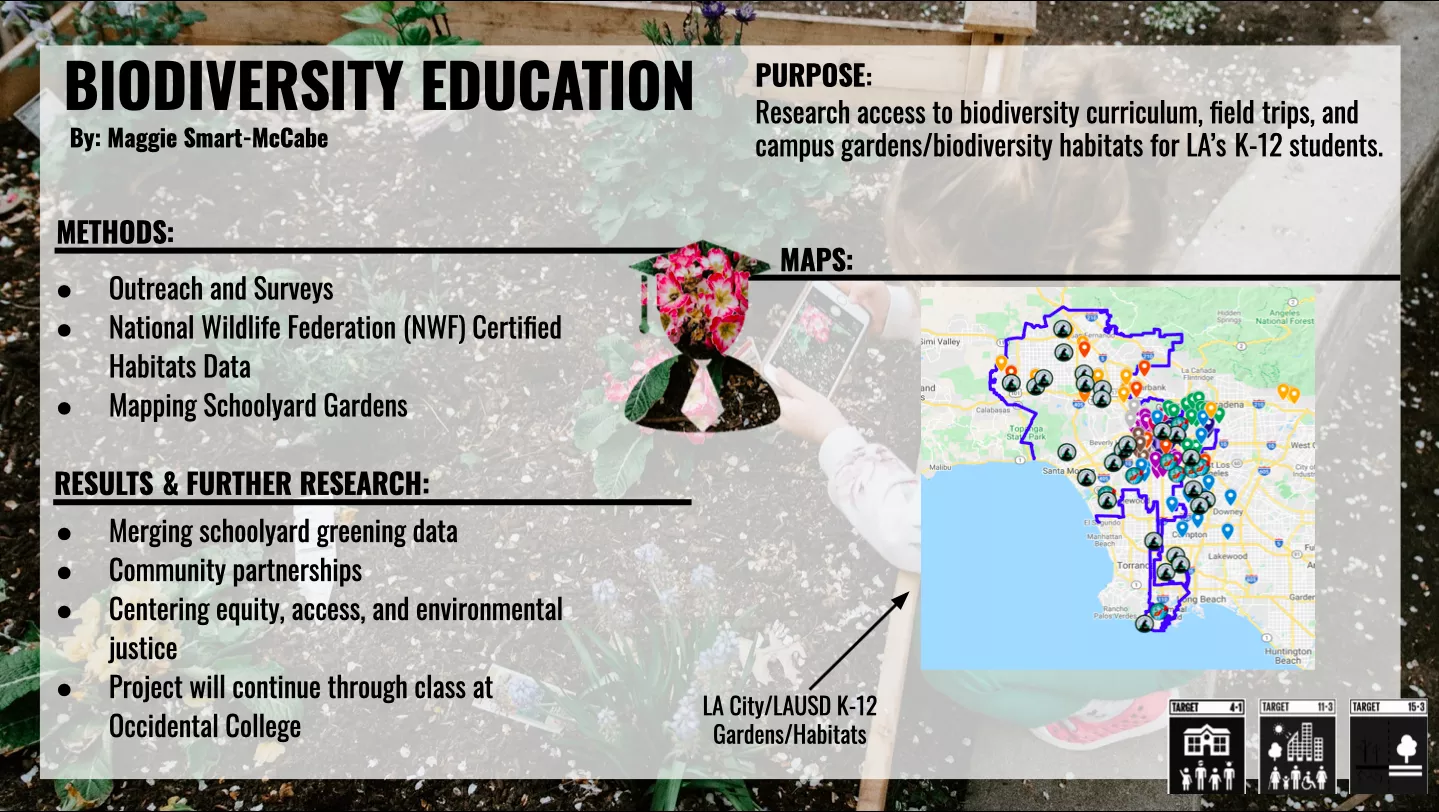
Governance & Management (McClaran Shirley)
Research Question: How can the city government better manage the SDGs while measuring, engaging, and enhancing biodiversity?
UN SDG Targets Addressed: 11.3, 15.5, 15.9
Biodiversity Index Indicators: 2.3a, 2.3b, 3.1a, 3.1b, 3.2b, 3.2c, 3.2d
Methodology: We produced research by conducting surveys and department interviews to gain insight into biodiversity enhancing programs. Fifteen City departments completed our survey, including: the Emergency Management Department, the Street Services Bureau (StreetsLA), the Department of Water & Power, and the Department of Neighborhood Empowerment. Respondents answered questions regarding programs, policies, or initiatives relating to biodiversity in their respective departments.
Results: This project recommends that the City adopt a Local Biodiversity Strategy and Action Plan (LBSAP) as defined by the Convention on Biological Diversity. This comprehensive City-wide plan can uplift City governance related to conservation and enhancement of biodiversity by streamlining the reporting and monitoring across sectors of governance.
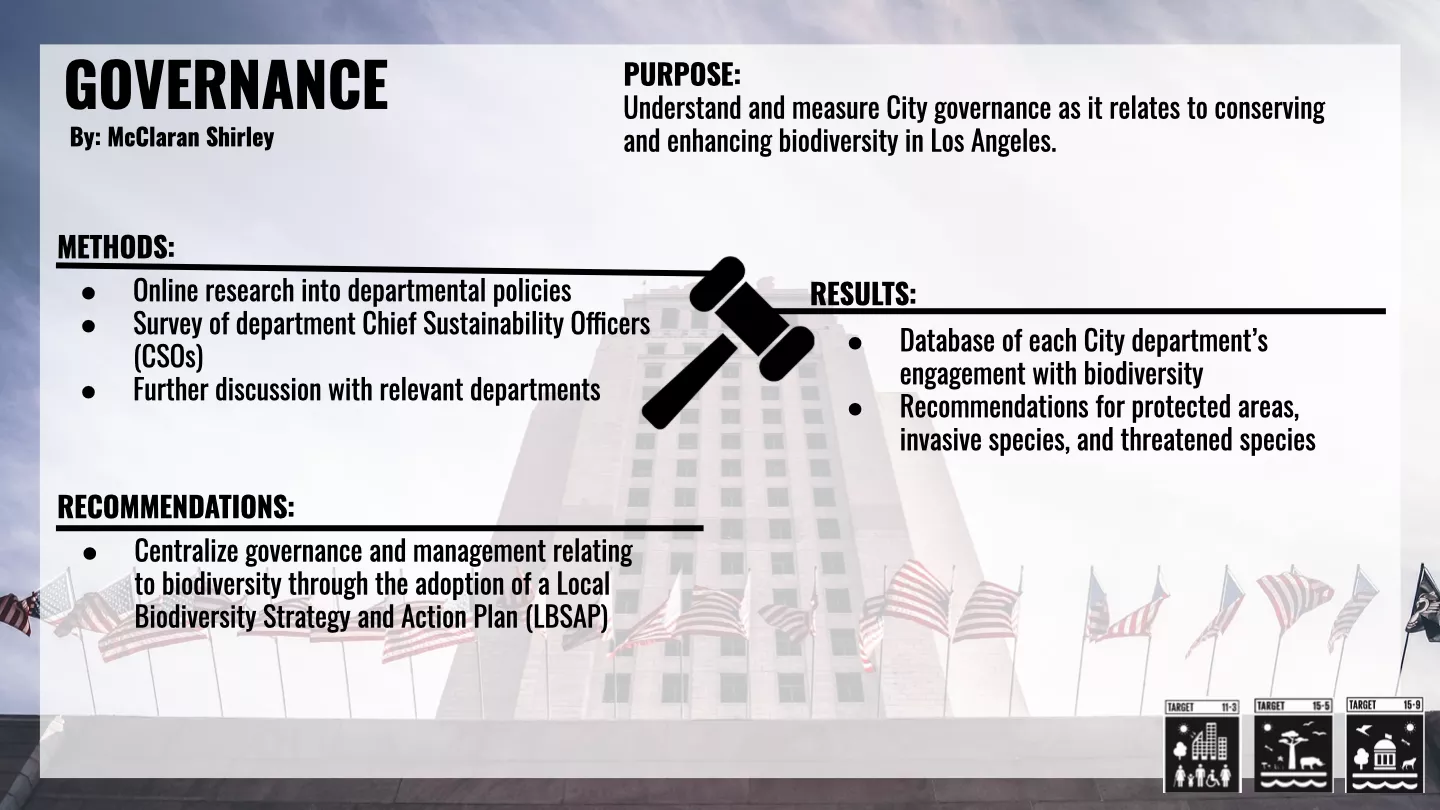
Community Stewardship Tool (Tyler Branum)
Research Question: What tools can we create for the Angeleno community so they can best practice biodiversity?
UN SDG Target Addressed: 15-1, 15-2, 15-5
Biodiversity Index Indicators: NA
Methodology: We collected data from Calscape and organized this information in excel to create a search feature that corresponds to zip codes within Los Angeles. Once a zip code is presented, the excel sheet will populate with relevant plant alliances and maintenance recommendations.
Results: Our work created a user-friendly stewardship decision tool that showcases key planting information. With this tool, both experts and average individuals are able to understand how they can easily improve biodiversity in their community.
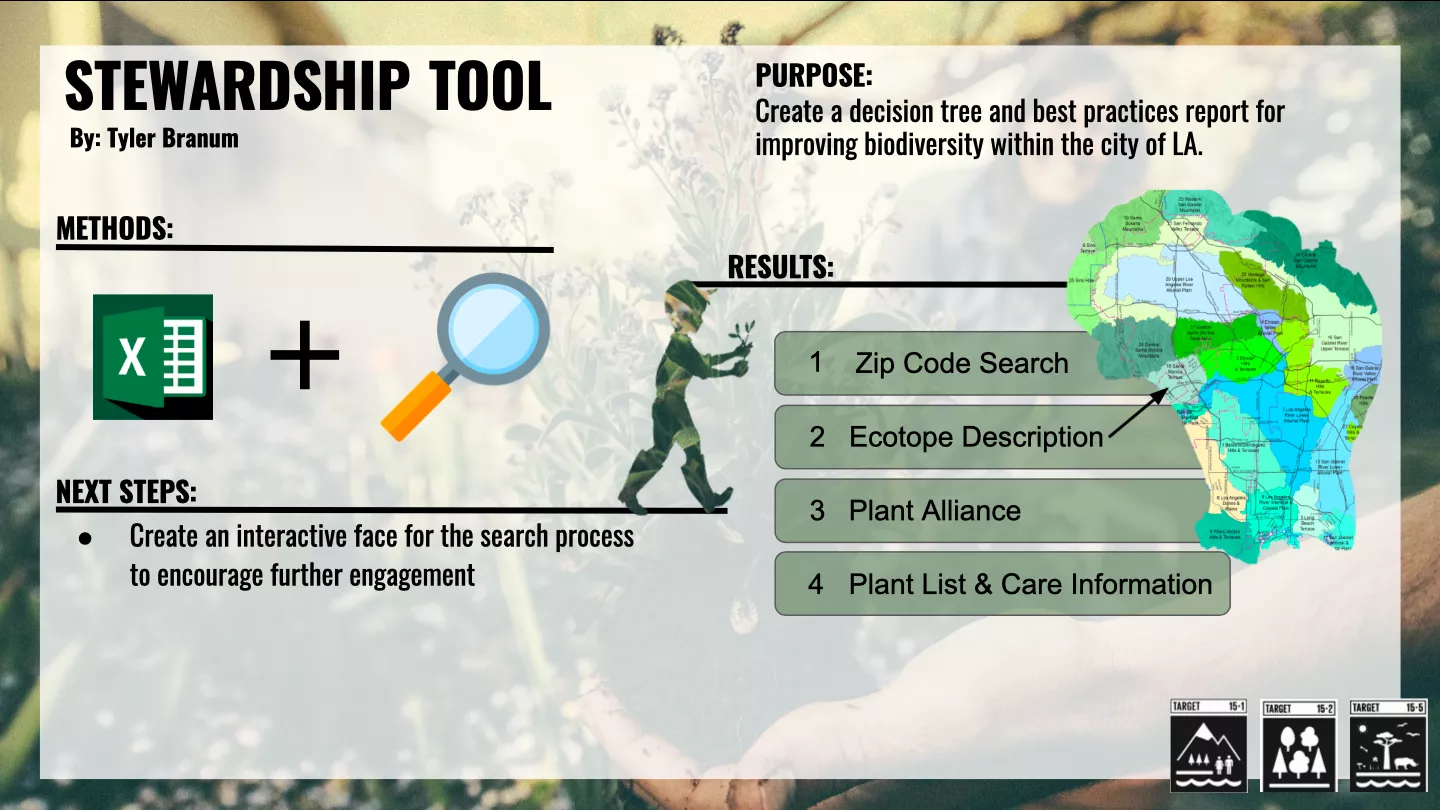
Why This Matters
Throughout our internship with the Los Angeles Mayor’s Office, our team was able to identify the strengths of the SDGs framework as it relates to biodiversity. We examined appropriate measures of sustainable development to understand how community members can coexist with Los Angeles’ native species. Each of our eight projects further the measurement of the L.A. Biodiversity Index and create a guide for L.A.’s Bureau of Sanitation and Environment. We worked to identify key data gaps, locate areas for improvement, and make biodiversity recommendations.
Our findings show that having a diverse ecosystem not only strengthens environmental quality, but also enriches City growth. Embracing and localizing the SDG framework in Los Angeles is crucial to build Sustainable Cities and Communities and protect Life on Land.
